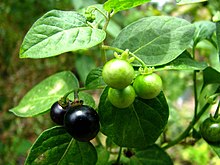Solanum americanum
| Solanum americanum | |
|---|---|

| |
| Scientific classification | |
| Kingdom: | Plantae |
| Clade: | Tracheophytes |
| Clade: | Angiosperms |
| Clade: | Eudicots |
| Clade: | Asterids |
| Order: | Solanales |
| Family: | Solanaceae |
| Genus: | Solanum |
| Species: | S. americanum
|
| Binomial name | |
| Solanum americanum | |
| Synonyms[1][2] | |
| |
Solanum americanum, commonly known as American black nightshade,[3] small-flowered nightshade[4] or glossy nightshade is a herbaceous flowering plant of wide though uncertain native range. The certain native range encompasses the tropics and subtropics of the Americas, Melanesia, New Guinea, and Australia.[5]
The plant is widely naturalised around the tropical Pacific and Indian Oceans, including Hawaiʻi, Indochina, Madagascar and Africa, possibly via anthropogenic introduction in these locales.
Solanum americanum is one of the most widespread and morphologically variable species belonging to the section Solanum.[6] It can be confused with other black nightshade species in the Solanum nigrum complex.[7]
Description[]
Solanum americanum grows up to 1–1.5 metres (39–59 in) tall and is an annual or short-lived perennial. The leaves are alternate on the branch, and vary greatly in size, up to 10 centimetres (3.9 in) long and 7 centimetres (2.8 in) broad, with a 4-centimetre (1.6 in) petiole and a coarsely wavy or toothed margin. The flowers are about 1 cm diameter, white or occasionally light purple, with yellow stamens. The fruit is a shiny black berry 5–10 millimetres (0.20–0.39 in) diameter, containing numerous small seeds.
Taxonomy[]
Solanum americanum is a variable taxon. It is considered by some botanists to be more than one species, and others recognise subspecies.[5] Some botanists have suggested that Solanum americanum may be conspecific with the European nightshade, S. nigrum.[2]
Toxicity[]

Research indicates the presence of toxic glycoalkaloids and there are warnings to be careful on the use of S. americanum as herbal medicine and food.[7] The green fruit is particularly poisonous and eating unripe berries has caused the death of children.[8] Ripe berries and foliage may also cause poisoning,[8] though the toxicity seems to diminish somewhat with ripening.[9] This is via high levels of the glycoalkaloids, solanine and solamargine.[10] Other toxins present in the plant include chaconine, solasonine, , gitogenin and traces of saponins,[11] as well as the tropane alkaloids scopolamine (hyoscine), atropine and hyoscyamine.[12]
Significant amounts of solasodine (0.65%) have been found in the green berries.[13] The ripe fruit also contains 0.3–0.45% solasonine,[13] and acetylcholine, and has a cholinesterase-inhibiting effect on human plasma.[11] In Transkei, rural people have a high incidence of esophageal cancer thought to be a result of using S. americanum as a food.[11] Livestock can also be poisoned by high nitrate levels in the leaves.[11]
Toxicity varies widely depending on the genetic strain and the location conditions, like soil and rainfall.[8][11] Poisonous plant experts advise: "...unless you are certain that the berries are from an edible strain, leave them alone."[14]
See also[]
References[]
- ^ "Solanum nodiflorum". Germplasm Resources Information Network (GRIN). Agricultural Research Service (ARS), United States Department of Agriculture (USDA). Retrieved 24 December 2017.
- ^ Jump up to: a b "Solanum americanum". Tropicos. Missouri Botanical Gardens – via The Plant List.
- ^ "Solanum americanum". Natural Resources Conservation Service PLANTS Database. USDA. Retrieved 17 November 2015.
- ^ BSBI List 2007 (xls). Botanical Society of Britain and Ireland. Archived from the original (xls) on 2015-06-26. Retrieved 2014-10-17.
- ^ Jump up to: a b Conn, Barry J. (2001). "Solanum americanum – New South Wales Flora Online". PlantNET – The Plant Information Network System. 2.0. Sydney, Australia: The Royal Botanic Gardens and Domain Trust. Retrieved 29 May 2013.
- ^ Edmonds & Chweya 1997, p. 93
- ^ Jump up to: a b Mohy-ud-dint, A.; Khan, Z.; Ahmad, M.; Kashmiri, M. A. (2010). "Chemotaxonomic value of alkaloids in Solanum nigrum complex" (PDF). Pakistan Journal of Botany. 42 (1): 653–660. Retrieved 29 May 2013.
- ^ Jump up to: a b c Tull, D. (1999). Edible and Useful Plants of Texas and the Southwest: A Practical Guide. University of Texas Press. ISBN 978-0-292-78164-1.
- ^ Niering, William A.; Olmstead, Nancy C. (1985) [1979]. The Audubon Society Field Guide to North American Wildflowers, Eastern Region. Knopf. p. 804. ISBN 0-394-50432-1.
- ^ Al Chami, L.; Mendez, R.; Chataing, B.; O'Callaghan, J.; Usubilliga, A.; Lacruz, L. (2003). "Toxicological effects of α-solamargine in experimental animals". Phytotherapy Research. 17 (3): 254–8. doi:10.1002/ptr.1122. PMID 12672156. S2CID 86042610.
- ^ Jump up to: a b c d e Nellis, David W. (1997). "Black nightshade Solanum americanum". Poisonous Plants and Animals of Florida and the Caribbean. Pineapple Press. pp. 76, 243. ISBN 978-1-56164-111-6.
- ^ Wildflowers of Tucson — Arizona Poisonous Tucson Plants
- ^ Jump up to: a b Edmonds & Chweya 1997, p. 66
- ^ Turner, Nancy J.; Aderka, P.von (2009). The North American guide to common poisonous plants and mushrooms. Timber Press. pp. 181–2. ISBN 978-0-88192-929-4.
External links[]
- Missouri Plants
- Solanum americanum: Occurrence data from Global Biodiversity Information Facility
- "Solanum americanum". Germplasm Resources Information Network (GRIN). Agricultural Research Service (ARS), United States Department of Agriculture (USDA).
- Pacific Island Ecosystems at Risk: Solanum americanum (very detailed description)
- Identifying nightshades as weeds
- Edmonds, Jennifer M.; Chweya, James A. (1997). Black Nightshades: Solanum Nigrum L. and Related Species. Promoting the conservation and use of underutilized and neglected crops. 15. Bioversity International. ISBN 978-92-9043-321-7.
- "Solanum americanum Mill". Solanaceae Source. — Images, specimens and a full list of scientific synonyms. Full descriptions and identification keys coming soon!
- Plants for a future
- Medina, Freddy R.; Ritchie, Lawrence S. (October–December 1980). "Molluscicidal Activity of the Puerto Rican Weed, Solanum nodiflorum, against Snail Hosts of Fasciola hepatica". Economic Botany. 34 (4): 368–375. doi:10.1007/bf02858313. JSTOR 4254217. S2CID 21001631.
- Solanum
- Flora of Hawaii
- Medicinal plants
- Plants used in traditional African medicine
- Plants described in 1768
- Taxa named by Philip Miller
